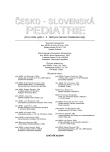Continual Monitoring of Electric Brain Activity in Newborns (aEEG – Amplitude Integrated EEG)
Authors:
J. Lukášková
Authors‘ workplace:
Dětská klinika FN, Hradec Králové
přednostka doc. MUDr. E. Pařízková, CSc.
Published in:
Čes-slov Pediat 2007; 62 (2): 91-97.
Category:
Review
Overview
Monitoring of aEEG is a simple method for monitoring of basic brain activity. It has been used in newborns since the end of eighties of previous century. It correlates with standard EEG and makes it possible to monitor continuously. According to literature this method can be used in mature newborns for the evaluation of the severity of perinatal asphyxia or another hypoxic insult and for the evaluation of the degree of severity of subsequent hypoxic-ischemic encephalopathy. It is possible to detect paroxysmal activity and to follow the influence of anticonvulsive therapy. In the immature newborns the method enables to follow maturation of the brain activity, evaluation of the severity of intracranial bleeding and possible prediction of further development. aEEG is a simple and easily reproducible method, which can help in the evaluation of further diagnostic and therapeutic procedure, but it does not substitute conventional EEG or imaging examinations of the brain.
Key words:
aEEG, hypoxic-ischemic encephalopathy, intracranial bleeding, neurological development, newborn
Labels
Neonatology Paediatrics General practitioner for children and adolescentsArticle was published in
Czech-Slovak Pediatrics

2007 Issue 2
Most read in this issue
- Multiple Intracranial Complications of Pansinusitis in Children
- Continual Monitoring of Electric Brain Activity in Newborns (aEEG – Amplitude Integrated EEG)
- Bone Marrow Transplantation in Children – Parents’ Point of View
- Teratogenic Phenylketonuria-related Embryopathy
